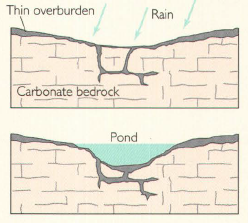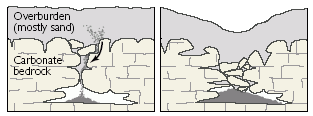Sinkholes can be both costly and deadly. The US Geological Survey estimates that sinkholes cause approximately $300 million in damage per year. Natural sinkholes form in Karst terrain—areas with bedrock that can be dissolved by groundwater, which are typically salt beds, limestone or other carbonate rock. Florida, which has large amounts of underground limestone, is particularly susceptible.
Natural sinkholes form when acidic water dissolves the bedrock, forming pathways and channels that are then filled with “overburden,” an upper layer of rock and soil. Man-made sinkholes can occur in any type of terrain, and may form when cracked or leaking pipes provide space for overburden to fall into a pipe and be carried away.
There are three main types of sinkholes.
Dissolution Sinkholes
A thin layer of overburden covers the bedrock; when the water wears the rock away, it leaves a depression that can fill with water and create a pool or marsh.

Cover-subsidence Sinkholes
When a thicker layer of overburden covers the bedrock, the underlying bedrock may wear away. If it carries the overburden with it, a depression remains. Cover-subsidence sinkholes occur most often when the overburden is mostly sand.
Cover-collapse Sinkholes
The most abrupt and catastrophic type of sinkhole, cover-collapse occurs when the overburden is mostly made of clay. Groundwater wears away the bedrock and pulls the overburden into the remaining space, leaving a void above it. Over time, the void grows upward until the roof finally collapses, creating a sudden and dramatic sinkhole. This type of sinkhole can also form as a result of cracked or leaking pipes where soil falls into the pipe and is washed away. As with natural sinkholes, the void grows upward until the roof collapses.

While most manmade sinkholes occur due to mining and irrigation, sinkholes—particularly the cover-collapse variety—are a large risk for wastewater utilities with damaged pipes. The first step in preventing a sinkhole caused by leaking pipes is running a strong sewer inspection program focused on I&I management.
A Case Study in Sinkhole Management
Consider the case of Macomb County, on Michigan’s 15 Mile interceptor, which experienced its third collapse last year. That sinkhole led to the evacuation of 23 homes on Christmas Eve. In an interview with the Detroit Free Press, James Heath, a retiree from the Detroit Water and Sewerage Department (DWSD), stated, “It’s a systemic problem with communities that fail to perform inspections like they should.”
According to the article, the pipeline was first installed in July 1972 as Macomb and Oakland counties were connected to Detroit’s wastewater treatment system. After the installation, the pipeline was left uninspected for seven years until it collapsed in 1979.
Upon inspection of that collapse, Jenny Engineering recommended inspecting the pipe every year until no changes were observed, and then no less frequently than every three years. Despite this recommendation, the history of sinkholes, and the prevalence of sinkhole-prone ground, inspections fell by the wayside.
The pipeline collapsed again in 2004, two years after Heath retired, leaving a sinkhole behind. This collapse prompted the transfer of the sewer system to Oakland and Macomb counties in 2009. However, after an inspection near the location of the ‘04 collapse in 2009, the interceptor was again left unexamined until the discovery of the most recent sinkhole in 2016.
The potential for injury and cost of repair aren’t the only problems caused by sinkholes. Sinkholes can have a ripple effect on watersheds and wastewater and stormwater systems around them. A central Florida sinkhole caused contaminated wastewater to leak into a main source of drinking water for the state in September of 2016. Regular, thorough inspection is vital to preventing catastrophic collapses. Sewer inspection equipment can assist in identifying and logging cracks, corrosion and sagging that may indicate infiltration and an impending sinkhole.
A strategic sewer inspection program can help you identify existing and potential issues, including sinkholes. Envirosight's Quickview airHD zoom assessment camera allows operators to quickly evaluate pipe condition and prioritize resource allocation. Schedule a demo to learn more:
Images modified from U.S. Geological Survey.


